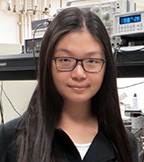Terahertz Metasurface Quantum-cascade Laser

Speaker: Luyao Xu
Affiliation: Ph.D. Candidate - UCLA
Abstract: Since its invention in 2001, the terahertz quantum cascade laser (THz QCL) has emerged as a compact semiconductor THz source capable of delivering milliwatt-level power or higher at various frequencies from 1.2 to 5.6 THz. One longstanding challenge for THz QCLs is combining high power output and high-quality beam pattern in one device, which is desired for many applications such as heterodyne spectroscopy, and real-time imaging (e.g. for biomedical or nondestructive inspection applications).
Vertical external-cavity-surface-emitting-laser (VECSEL) has been demonstrated as a successful approach to achieve high power and good beam pattern for semiconductor lasers in the visible and near-infrared. However, the VECSEL concept has been impossible to implement for QCLs owing to “intersubband selection rule”: the intersubband transitions in cascaded quantum wells — the gain medium of QCLs — are only allowed to interact with and provide gain to the electric field polarized perpendicular to the wells. This is incompatible with the natural polarization for surface incident waves in a VECSEL cavity.
This dissertation reports the development of THz metasurface quantum-cascade VECSEL (QC-VECSEL) — a new class of THz QCL to achieve high power output combined with an excellent beam pattern. The enabling component is an active metasurface reflector composed of a sub-wavelength array of metallic microcavity antennas; each antenna efficiently couples in THz radiation, amplifies it and re-radiates into the free space. Lasing is possible when an active metasurface is paired with an output coupler form a low-loss cavity. This new architecture gives the ability to scale up output power with the metasurface area while maintaining a good beam pattern shaped by the external cavity. Moreover, this approach can leverage ongoing advances in novel metasurfaces to realize versatile functionality for QC-VECSELs. The demonstration of THz QC-VECSEL marks the “two firsts”: the first VECSEL in the THz range and the first laser built around an active metasurface. Throughout this PhD work, a wide variety of THz metasurface QC-VECSELs varying in metasurface and cavity designs have been experimentally demonstrated, which have yielded considerable high-performance results, including best beam pattern reported combined with high power, record high continuous wave power at high temperature, polarization and wavefront engineering.
Biography: Luyao Xu is currently a Ph.D. candidate in the Electrical Engineering Department at UCLA. She received the M.S. degree in Electrical Engineering from UCLA in 2013, and B.S. Degree in Optical Engineering from Zhejiang University, China in 2011. Throughout the PhD career, Luyao has authored and co-authored 15 publications (including 5 first-author journal papers, 8 conference presentations, 1 issued and 1 pending US patent). She has received awards including UCLA PhD Dissertation Year Fellowship 2016-2017, Best Student Presentation Award in SPIE Photonics West 2016, SPIE Optics and Photonics Scholarship 2015, First Place Award in PhD Preliminary Exam (physical & wave electronics) 2013, UCLA Departmental Graduate Student Fellowship 2011.
For more information, contact Prof. Benjamin S. Williams (bswilliams@ucla.edu)
Date/Time:
Date(s) - Apr 26, 2017
2:00 pm - 4:00 pm
Location:
E-IV Maxwell Room #57-124
420 Westwood Plaza - 5th Flr. , Los Angeles CA 90095
